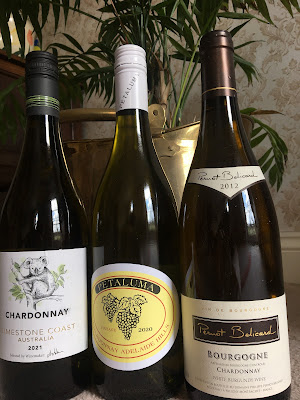Monday 30 May 2022
Lesser-Known Grapes from Tesco
Sunday 29 May 2022
Four French Rosés For Summer
Sunday 22 May 2022
Supermarket Crisp White And Big Red
Bordeaux was my first oenological love - we had taken a weekend break to northern France in the car and decided to bring back a few bottles with us. They cost the equivalent of a few pounds each and I had plucked them off the shelves pretty much at random, but back home every bottle we opened was at least thoroughly enjoyable if not rather better and I realised that I actually liked wine (or French wine bought in France, to be specific) a lot more than the generic UK-brewed beers and lagers I had previously consumed.
Not long afterwards, I took on a high-travel role that saw me visiting Vienna most months; to fend off the boredom of endless evenings with just a newspaper's business pages for company in one of the world's great cities, I started eating (and drinking) at slightly better restaurants and developed a taste for Michelin-quality food and high-end Austrian wines.
It's easily done when the company is paying for you.
So, Austrian Gruener and red Bordeaux remain my go-to for a brace of enjoyable wines to accompany a meal.
I met Markus Huber a couple of times at various tastings and was impressed by the quality of his wines - for Morrison's to get his wine and stock it at around £7 is no mean feat.
This purchase was a chance find - I happened to be in Morrison's and it happened to be marked down by a few pounds; I now wish I'd bought more, but I can say that of many wines in my makeshift cellar and I still have more than I can get through.
The Lidl Bordeaux was recommended by Richard Bampfield MW; I have reviewed it previously, but the 2017 now has a bit more bottle age and can be viewed with some perspective.
I bought a case each of the 2016 and 2017 when they were on special offer; the '16 is the better vintage but the '17 being lighter and fresher is ready for drinking sooner (on this tasting, it will still benefit from a few more years).
I decanted the red around an hour before the meal; with hindsight, this was too little. It can take (and will benefit from) several hours in the decanter to soften the tannins and allow the fruit to come to the fore.
The Gruener was chilled and aerated; it shows well on first pouring and doesn't require decanting, but it does improve greatly with more air.
Morrisons The Best Gruner Veltliner 2019, Niederoesterreich (£7.50, Morrison's)
citrus, orange blossom and honeysuckle, stone fruits, white pepper and crushed slate; crisp and fresh with lemon-lime, pineapple, fresh yellow stone fruits and orchard fruits; white pepper, minerality and some dried green herbs.
Thoroughly enjoyable.
A versatile food wine, match with picnic foods, a wide range of starters, meaty white fish or roasted white meats.
Lidl Saint Emilion Grand Cru (£11.99, Lidl)
Saturday 21 May 2022
Two Co-Op Medal Winners
Co-op Irresistible Gavi di Gavi 2021, Italy (£8.50)
Friday 20 May 2022
The CWB Languedoc Rosé-Off
Thursday 19 May 2022
The CWB Sauvignon Blanc Off
Saturday 14 May 2022
The CWB Meta Aussie Viognier-Off
Saturday 7 May 2022
A(nother) CWB Chardonnay-Off
Friday 6 May 2022
The CWB Inexpensive Italian White-Off
Thursday 5 May 2022
The CWB Tesco Argentinean Malbec-Off
Once a major grape in Bordeaux, Malbec was relegated to an also-ran in the 1950s; it continues to grown along the Atlantic side of the country in the Loire and Cahors, but its spiritual home these days is across the Atlantic in Argentina.
A thick-skinned, heat-loving grape, Malbec produces dark, inky, intense wines wines with plummy flavours. It is perhaps the heir to Aussie Shiraz, a New World grape that makes Big Reds that can take a lot of oak.
Also like Aussie Shiraz, it is capable of deftness as well as heft; in the right hands, it is plummy but not blowsy, fruited and spicy but fresh and food-friendly
The Malbecs of Argentina are an historic clone brought over from France in the 19th century that is now considered extinct in its native country. Argentine Malbec is has a deep colour, intense fruit and a plush, velvety texture.
Malbec is one of the UK's more popular grapes and is a great match for grilled red meats, especially char-grilled bone-in steaks.
Here are three Argentinean Malbecs from Tesco, all with a bit of age.
My personal favourite here is the DV Catena for its European-style fresh fruit, lower alcohol and sophisticated oaking.
Also from Catena, the Tesco Finest is a little more expressive, so think barbecue more than dinner table. With a degree more alcohol, the Vinalba is a more concentrated, bigger, fuller wine that demands rich, gamey foods.
All these wines will benefit from an hour or so in the decanter and have further aging potential.






















